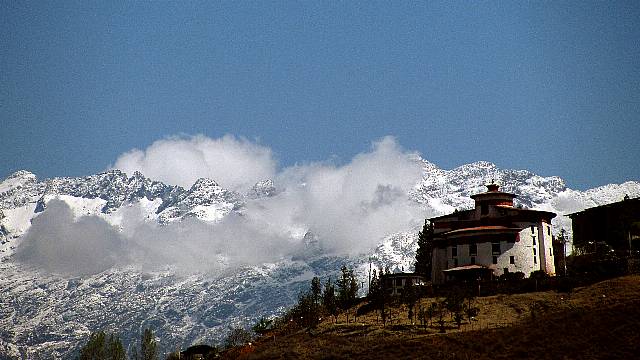The dramatic effect rainfall has on the evolution of mountainous landscapes is widely debated among geologists.
However, new research led by the University of Bristol clearly calculates its impact, furthering the understanding of how peaks and valleys have developed over millions of years.
Its findings published in Science Advances focused on the Himalaya mountain range.
That’s what makes this discovery such an exciting breakthrough, as it strongly supports the notion that atmospheric and solid earth processes are intimately connected
Researchers say they pave the way for forecasting the possible impact of climate change on landscapes and, in turn, human life.
Lead author Dr Byron Adams, Royal Society Dorothy Hodgkin Fellow at the university’s Cabot Institute for the Environment, said: “It may seem intuitive that more rain can shape mountains by making rivers cut down into rocks faster.
“But scientists have also believed rain can erode a landscape quickly enough to essentially ‘suck’ the rocks out of the Earth, effectively pulling mountains up very quickly.
“Both these theories have been debated for decades because the measurements required to prove them are so painstakingly complicated.
“That’s what makes this discovery such an exciting breakthrough, as it strongly supports the notion that atmospheric and solid earth processes are intimately connected.”
The study was based in the central and eastern Himalaya of Bhutan and Nepal, because this region of the world has become one of the most sampled landscapes for erosion rate studies.
Dr Adams, together with collaborators from Arizona State University (ASU) and Louisiana State University, used cosmic clocks within sand grains to measure the speed at which rivers erode the rocks beneath them.
He explained: “When a cosmic particle from outer space reaches Earth, it is likely to hit sand grains on hillslopes as they are transported toward rivers.
This model allows us for the first time to quantify how rainfall affects erosion rates in rugged terrain
“When this happens, some atoms within each grain of sand can transform into a rare element.
“By counting how many atoms of this element are present in a bag of sand, we can calculate how long the sand has been there, and therefore how quickly the landscape has been eroding.
“Once we have erosion rates from all over the mountain range, we can compare them with variations in river steepness and rainfall.
“However, such a comparison is hugely problematic because each data point is very difficult to produce and the statistical interpretation of all the data together is complicated.”
The researchers were able to address this challenge by combining regression techniques with numerical models of how rivers erode.
Dr Adams said: “This model allows us for the first time to quantify how rainfall affects erosion rates in rugged terrain.”
Research collaborator Professor Kelin Whipple, professor of geology at ASU, said the findings show how critical it is to account for rainfall when assessing patterns of tectonic activity using topography.
Researchers say the findings carry important implications for land use management, infrastructure maintenance, and hazards in the Himalaya.
In the Himalaya, there is the risk that high erosion rates can drastically increase sedimentation behind dams, jeopardising critical hydropower projects.
The findings also suggest greater rainfall can undermine hillslopes, increasing the risk of debris flows or landslides, some of which may be large enough to dam the river, creating a new hazard – lake outburst flood.
The research was funded by the Royal Society, the UK’s Natural Environmental Research Council, and the US’s National Science Foundation.







